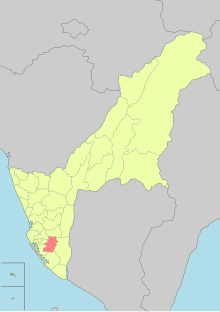Fongshan District
Fongshan
鳳山區 | |
|---|---|
| Fengshan District [1] | |
 Downtown Fongshan | |
 Location of Fongshan District | |
| Country | Republic of China (Taiwan) |
| Municipality | Kaohsiung |
| Area | |
• Total | 26.76 km2 (10.33 sq mi) |
| Population (January 2016) | |
• Total | 356,507 |
| • Density | 13,000/km2 (35,000/sq mi) |


Fongshan District (Chinese: 鳳山區; Hanyu Pinyin: Fèngshān Qū; Tongyong Pinyin: Fòngshan Cyu; Pe̍h-ōe-jī: Hōng-soaⁿ-khu) is a district located in southern Kaohsiung, Taiwan. Fongshan is one of the administrative centers of Kaohsiung and is home to the Chinese Military Academy. There are three military units currently located in Fongshan. Both Chinese Military Academy and R.O.C. Army Infantry School were migrated from mainland China and re-established here in 1950. Chung Cheng Armed Forces Preparatory School was established in 1976. These three units used to be the main economic driving force, but their importance seems to diminish gradually as Fongshan has established itself as a conjunction between Pingtung City and Kaohsiung.
Although there are several industrial zones at the rim or outskirt of the city, the major life style in Fongshan seems to be very residential. Lots of apartments were built near the proximity of Kaohsiung City as a result of shifting economic weight. Like most of areas in Taiwan, it also has many night markets scattered around within the city. Most of the night markets run until 2:00 am. Some of them run business on different days of a week, but some others are all year round. Some of them are temporary, while others have become permanent establishments.
History
During the Dutch era, the current location of Fongshan was called Pongsoya (see Linbian, Pingtung), a group of eight Makatao villages and one of the most populous areas of Taiwan.
Qing Dynasty
In the Qing Dynasty, Fongshan County (鳳山縣) included areas south of Tainan (then called "Taiwan-fu") and west of the mountains. In 1875, the southern part of Fongshan County was separated into Hengchun County (恆春縣).
Empire of Japan
In 1901, during Japanese rule, Hōzan Chō (鳳山廳) was one of twenty local administrative offices established. According to the 1904 census, Hozan town had a population of 5,750, whereas Hozan District had a population 173,016.[2] In 1909, this unit was merged into Tainan Chō (臺南廳). From 1920 to 1945, under the prefecture system, Hōzan Town (鳳山街) was administered under Hōzan District (鳳山郡), Takao Prefecture. After the colonial government started to develop Takao Harbor in the early 20th century, the importance of Fongshan was declining.
Republic of China
Fongshan was the capital of Kaohsiung County, established in 1945 as an urban township. It was upgraded to a county-controlled city on 1 July 1972, and has been a city seat of Kaohsiung City since 25 December 2010 along with Lingya District.
Built up area
This township is part of Kaohsiung built up area which encompasses 10 cities (or townships) out of 18 in official Kaohsiung Metro Area.
Climate
Fongshan is in the tropical zone. Average temperature is 23 Celsius (°C). Average precipitation is 1,500 to 2,000 millimeters.
Government institutions
Tourist attractions
- Caogong Temple
- Cheng Huang Temple
- Chenglan Fort
- Dadong Arts Center
- Dongbian Gate
- Dongfu Bridge
- Fengshan Longshan Temple
- Fengshan Stadium
- Fongyi Tutorial Academy
- Former Japanese Navy Fongshan Communication Center
- Kaohsiung City Symphony Orchestra
- Pingcheng Fort
- Shuangcih Pavilion
- Syunfong Fort
- Weiwuying Metropolitan Park
- Zhonghua Street Night Market
Transportation

Roads
- National Highway No. 1 (Taiwan)
- Provincial Highway No. 1 (Taiwan)
- Provincial Highway No. 1 - Shu (Taiwan)
- Provincial Highway No. 25 (Taiwan)
- Provincial Highway No. 88 (Taiwan)
Railroads
- Fongshan West Station, Fongshan Station, Dadong Station and Fongshan Junior High School Station of Kaohsiung Mass Rapid Transit
- Fengshan Station of Taiwan Railways Administration
Notable natives
- Chen Chi-chuan, former Mayor of Kaohsiung
- Tyzen Hsiao, composer, pianist and conductor
See also
References
- ^ "Glossary of Names for Admin Divisions" (PDF). placesearch.moi.gov.tw. Ministry of Interior of the ROC. Retrieved 12 June 2015.
- ^ Takekoshi (1907), p. 199-200.
